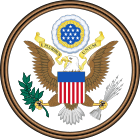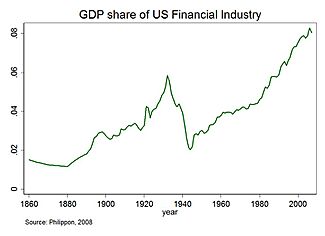Dodd–Frank Wall Street Reform and Consumer Protection Act facts for kids
 |
|
| Long title | An Act to promote the financial stability of the United States by improving accountability and transparency in the financial system, to end "too big to fail", to protect the American taxpayer by ending bailouts, to protect consumers from abusive financial services practices, and for other purposes. |
|---|---|
| Nicknames | Dodd–Frank Act |
| Enacted by | the 111th United States Congress |
| Effective | July 21, 2010 |
| Citations | |
| Public law | Pub.L. 111-203 |
| Statutes at Large | 124 Stat. 1376–2223 |
| Codification | |
| Acts amended | Commodity Exchange Act Consumer Credit Protection Act Federal Deposit Insurance Act Federal Deposit Insurance Corporation Improvement Act of 1991 Federal Reserve Act Financial Institutions Reform, Recovery, and Enforcement Act of 1989 International Banking Act of 1978 Protecting Tenants at Foreclosure Act Revised Statutes of the United States Securities Exchange Act of 1934 Truth in Lending Act |
| Titles amended | 7 U.S.C.: Agriculture 12 U.S.C.: Banks and Banking 15 U.S.C.: Commerce and Trade |
| Legislative history | |
|
|
| Major amendments | |
| Economic Growth, Regulatory Relief and Consumer Protection Act | |
| United States Supreme Court cases | |
|
|
The Dodd–Frank Wall Street Reform and Consumer Protection Act, commonly referred to as Dodd–Frank, is a United States federal law that was enacted on July 21, 2010. The law overhauled financial regulation in the aftermath of the Great Recession, and it made changes affecting all federal financial regulatory agencies and almost every part of the nation's financial services industry.
Responding to widespread calls for changes to the financial regulatory system, in June 2009, President Barack Obama introduced a proposal for a "sweeping overhaul of the United States financial regulatory system, a transformation on a scale not seen since the reforms that followed the Great Depression." Legislation based on his proposal was introduced in the United States House of Representatives by Congressman Barney Frank (D-MA) and in the United States Senate by Senator Chris Dodd (D-CT). Most congressional support for Dodd–Frank came from members of the Democratic Party; three Senate Republicans voted for the bill, allowing it to overcome the Senate filibuster.
Dodd–Frank reorganized the financial regulatory system, eliminating the Office of Thrift Supervision, assigning new jobs to existing agencies similar to the Federal Deposit Insurance Corporation, and creating new agencies like the Consumer Financial Protection Bureau (CFPB). The CFPB was charged with protecting consumers against abuses related to credit cards, mortgages, and other financial products. The act also created the Financial Stability Oversight Council and the Office of Financial Research to identify threats to the financial stability of the United States of America, and gave the Federal Reserve new powers to regulate systemically important institutions. To handle the liquidation of large companies, the act created the Orderly Liquidation Authority. One provision, the Volcker Rule, restricts banks from making certain kinds of speculative investments. The act also repealed the exemption from regulation for security-based swaps, requiring credit-default swaps and other transactions to be cleared through either exchanges or clearinghouses. Other provisions affect issues such as corporate governance, 1256 Contracts, and credit rating agencies.
Dodd–Frank is generally regarded as one of the most significant laws enacted during the presidency of Barack Obama. Studies have found the Dodd–Frank Act has improved financial stability and consumer protection, although there has been debate regarding its economic effects. In 2017, Federal Reserve Chairwoman Janet Yellen stated that "the balance of research suggests that the core reforms we have put in place have substantially boosted resilience without unduly limiting credit availability or economic growth." Some critics argue it failed to provide adequate regulation to the financial industry; others, such as American Action Forum and RealClearPolicy, argued that the law had a negative impact on economic growth and small banks. A partial repeal to the Dodd–Frank Act, leaving in place its central structure, was passed in 2018 with the Economic Growth, Regulatory Relief, and Consumer Protection Act.
Origins and proposal

The financial crisis of 2007–2008 led to widespread calls for changes in the regulatory system. In June 2009, President Obama introduced a proposal for a "sweeping overhaul of the United States financial regulatory system, a transformation on a scale not seen since the reforms that followed the Great Depression".
As the finalized bill emerged from conference, President Obama said that it included 90 percent of the reforms he had proposed. Major components of Obama's original proposal, listed by the order in which they appear in the "A New Foundation" outline, include:
- The consolidation of regulatory agencies, elimination of the national thrift charter, and new oversight council to evaluate systemic risk;
- Comprehensive regulation of financial markets, including increased transparency of derivatives (bringing them onto exchanges);
- Consumer protection reforms including a new consumer protection agency and uniform standards for "plain vanilla" products as well as strengthened investor protection;
- Tools for financial crisis, including a "resolution regime" complementing the existing Federal Deposit Insurance Corporation (FDIC) authority to allow for orderly winding down of bankrupt firms, and including a proposal that the Federal Reserve (the "Fed") receive authorization from the Treasury for extensions of credit in "unusual or exigent circumstances"; and
- Various measures aimed at increasing international standards and cooperation including proposals related to improved accounting and tightened regulation of credit rating agencies.
At President Obama's request, Congress later added the Volcker Rule to this proposal in January 2010.
Overview


The Dodd–Frank Wall Street Reform and Consumer Protection Act is categorized into 16 titles and, by one law firm's count, it requires that regulators create 243 rules, conduct 67 studies, and issue 22 periodic reports.
The stated aim of the legislation is
To promote the financial stability of the United States by improving accountability and transparency in the financial system, to end "too big to fail," to protect the American taxpayer by ending bailouts, to protect consumers from abusive financial services practices, and for other purposes.
The Act changes the existing regulatory structure, by creating a number of new agencies (while merging and removing others) in an effort to streamline the regulatory process, increasing oversight of specific institutions regarded as a systemic risk, amending the Federal Reserve Act, promoting transparency, and additional changes. The Act's intentions are to provide rigorous standards and supervision to protect the economy and American consumers, investors and businesses; end taxpayer-funded bailouts of financial institutions; provide for an advanced warning system on the stability of the economy; create new rules on executive compensation and corporate governance; and eliminate certain loopholes that led to the 2008 economic recession. The new agencies are either granted explicit power over a particular aspect of financial regulation, or that power is transferred from an existing agency. All of the new agencies, and some existing ones that are not currently required to do so, are also compelled to report to Congress on an annual (or biannual) basis, to present the results of current plans and explain future goals. Important new agencies created include the Financial Stability Oversight Council, the Office of Financial Research, and the Bureau of Consumer Financial Protection.
Of the existing agencies, changes are proposed, ranging from new powers to the transfer of powers in an effort to enhance the regulatory system. The institutions affected by these changes include most of the regulatory agencies currently involved in monitoring the financial system (Federal Deposit Insurance Corporation (FDIC), U.S. Securities and Exchange Commission (SEC), Office of the Comptroller of the Currency (OCC), Federal Reserve (the "Fed"), the Securities Investor Protection Corporation (SIPC), etc.), and the final elimination of the Office of Thrift Supervision (further described in Title III—Transfer of Powers to the Comptroller, the FDIC, and the FED).
As a practical matter, prior to the passage of Dodd–Frank, investment advisers were not required to register with the SEC if the investment adviser had fewer than 15 clients during the previous 12 months and did not hold himself out generally to the public as an investment adviser. The act eliminates that exemption, rendering numerous additional investment advisers, hedge funds, and private equity firms subject to new registration requirements. However, the Act also shifted oversight of non-exempt investment advisers with less than $100 million in assets under management and not registered in more than 15 states to state regulators. A study published in the American Economic Review in 2019 (by Ben Charoenwong of the National University of Singapore, Alan Kwan at Hong Kong University, and Tarik Umar at Rice University) found that this switch in enforcement to state regulators increased misconduct among investment advisers by thirty to forty percent, with a bigger increase in areas with less sophisticated clients, less competition, and among advisers with more conflicts of interest, most likely because on average state regulators have less resources and enforcement capacity compared to the SEC.
Certain non-bank financial institutions and their subsidiaries will be supervised by the Fed in the same manner and to the same extent as if they were a bank holding company.
To the extent that the Act affects all federal financial regulatory agencies, eliminating one (the Office of Thrift Supervision) and creating two (Financial Stability Oversight Council and the Office of Financial Research) in addition to several consumer protection agencies, including the Bureau of Consumer Financial Protection, this legislation in many ways represents a change in the way America's financial markets will operate in the future. Few provisions of the Act became effective when the bill was signed.
Provisions
The law has various titles relating to:
- Financial Stability;
- Orderly Liquidation Authority;
- Transfer of Powers to the Comptroller, the FDIC, and the Fed;
- Regulation of Advisers to Hedge Funds and Others;
- Insurance;
- Improvements to Regulation;
- Wall Street Transparency and Accountability;
- Payment, Clearing, and Settlement Supervision;
- Investor Protections and Improvements to the Regulation of Securities;
- Bureau of Consumer Financial Protection;
- Federal Reserve System Provisions;
- Improving Access to Mainstream Financial Institutions;
- Pay It Back Act;
- Mortgage Reform and Anti-Predatory Lending Act;
- Miscellaneous Provisions; and
- Section 1256 Contracts.
Images for kids
-
President Barack Obama meeting with Rep. Barney Frank, Sen. Dick Durbin, and Sen. Chris Dodd, at the White House prior to a financial regulatory reform announcement on June 17, 2009
-
Representative Barney Frank, co-architect of the Act
-
Senator Richard Shelby, the top-ranking Republican on the Senate Banking Committee
See also
- Brown–Kaufman amendment
- Chicago Stock Exchange
- Commodity Futures Trading Commission
- Financial crisis of 2007–2010
- Financial privacy laws in the United States
- Financial regulation
- List of financial regulatory authorities by country
- NASDAQ
- New York Stock Exchange
- Office of Financial Research
- Regulation D (SEC)
- Regulatory responses to the subprime crisis
- Securities Commission
- Securities regulation in the United States
- Stock exchange
- Subprime mortgage crisis solutions debate
- Swiss referendum "against corporate Rip-offs" of 2013
- Trading Places
- Volcker Rule
- Wall Street reform
- Comprehensive Capital Analysis and Review
- Related legislation
- 1933: Securities Act of 1933
- 1934: Securities Exchange Act of 1934
- 1938: Temporary National Economic Committee (establishment)
- 1939: Trust Indenture Act of 1939
- 1940: Investment Advisers Act of 1940
- 1940: Investment Company Act of 1940
- 1968: Williams Act (Securities Disclosure Act)
- 1975: Securities and Exchange Act
- 1982: Garn–St. Germain Depository Institutions Act
- 1999: Gramm–Leach–Bliley Act
- 2000: Commodity Futures Modernization Act of 2000
- 2002: Sarbanes–Oxley Act
- 2003: Fair and Accurate Credit Transactions Act of 2003
- 2006: Credit Rating Agency Reform Act of 2006
- 2018: Economic Growth, Regulatory Relief and Consumer Protection Act





